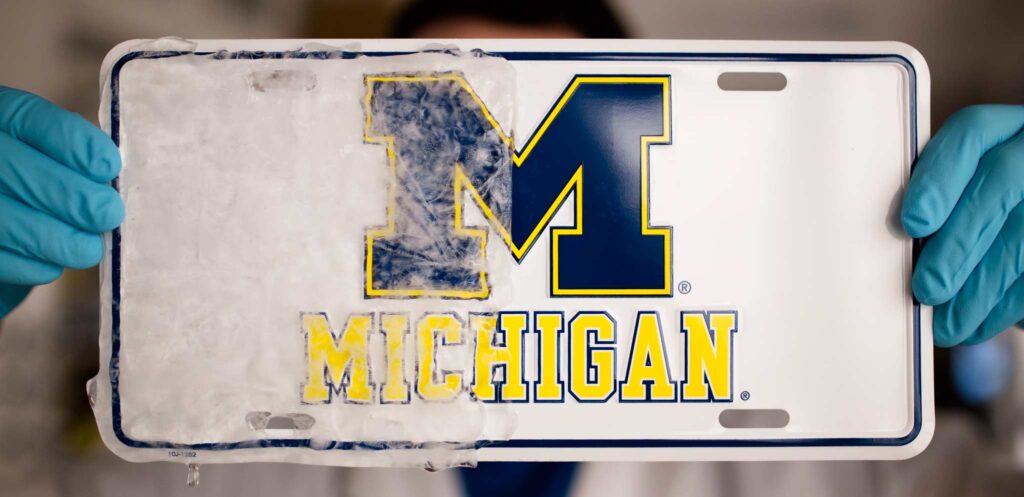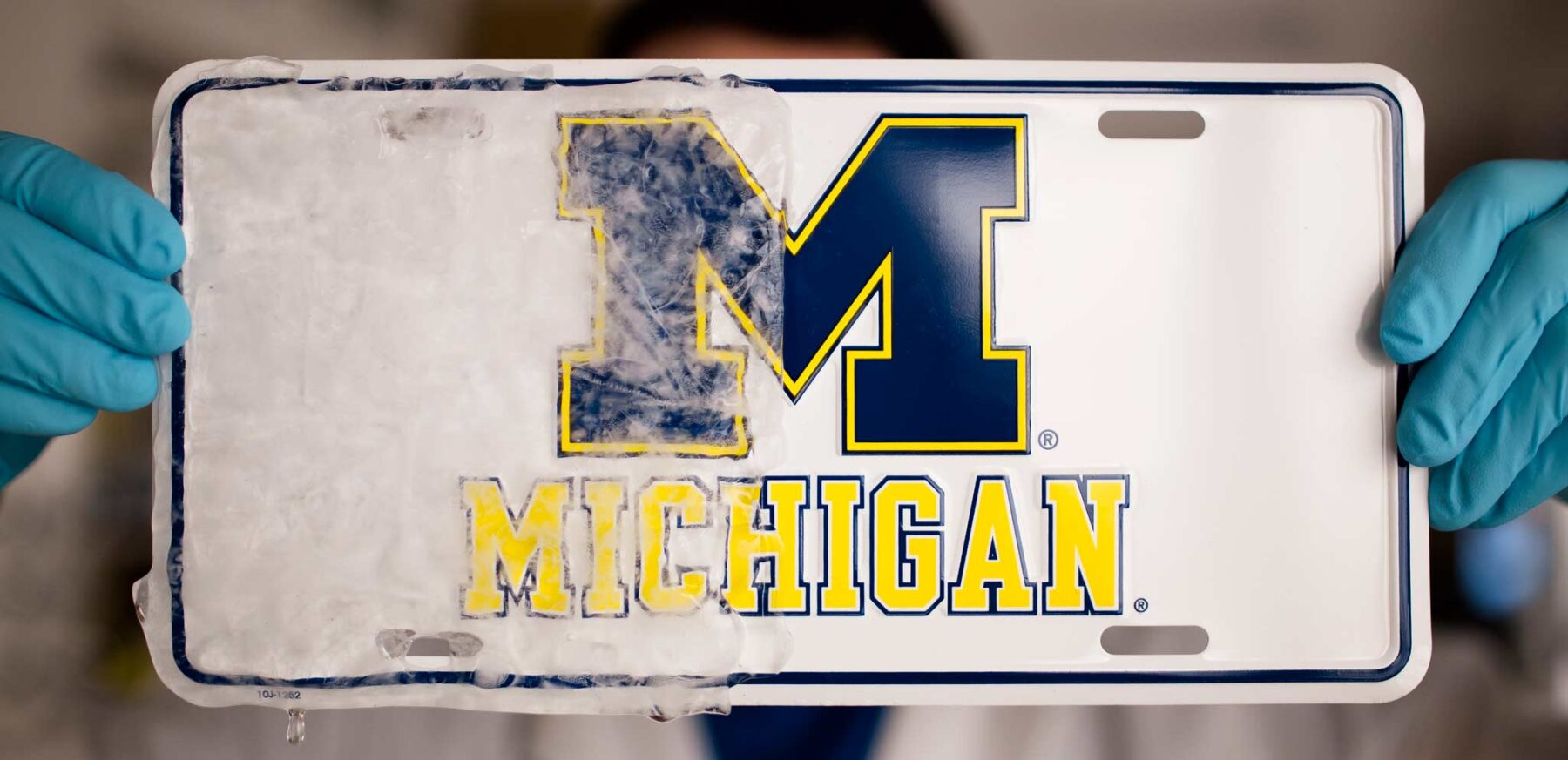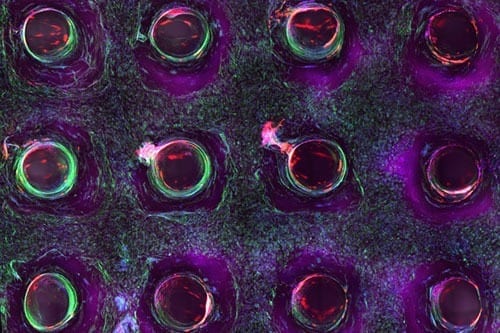
On your car windshield, ice is a nuisance. But on an airplane, a wind turbine, an oil rig or power line, it can be downright dangerous. And removing it with the methods that are available today—usually chemical melting agents or labor-intensive scrapers and hammers—is difficult and expensive work.
That could soon change thanks to a durable, inexpensive ice repellent coating developed by University of Michigan researchers. Thin, clear and slightly rubbery to the touch, the spray-on formula could make ice slide off equipment, airplanes and car windshields with only the force of gravity or a gentle breeze. This could have major implications in industries like energy, shipping and transportation, where ice is a constant problem in cold climates.
The new coating could also lead to big energy savings in freezers, which today rely on complex and energy-hungry defrosting systems to stay frost-free. An ice-repelling coating could do the same job with zero energy consumption, making household and industrial freezers up to 20 percent more efficient. The coating is detailed in a new paper published in the journal Science Advances.
Made of a blend of common synthetic rubbers, the new formula marks a departure from earlier approaches to icephobic coatings, which relied on making surfaces either very water repellent or very slippery.
“Researchers had been trying for years to dial down ice adhesion strength with chemistry, making more and more water-repellent surfaces,” said Materials Science and Engineering graduate student Kevin Golovin. “We’ve discovered a new knob to turn, using physics to change the mechanics of how ice breaks free from a surface.”
Led by U-M Materials Science and Engineering associate professor Anish Tuteja, the team initially experimented with water-repelling surfaces as well, but found that they weren’t effective at shedding ice. But during their experiments, they noticed something unexpected: rubbery coatings worked best for repelling ice, even when they weren’t water repellent. Eventually, they discovered that the ability to shed water wasn’t important at all. The rubbery coatings repelled ice because of a different phenomenon, called “interfacial cavitation.”
Golovin explains that two rigid surfaces—say, ice and your car windshield—can stick tightly together, requiring a great deal of force to break the bond between them. But because of interfacial cavitation, a solid material stuck to a rubbery surface behaves differently. Even a small amount of force can deform the rubbery surface, breaking the solid free.
“Nobody had explored the idea that rubberiness can reduce ice adhesion,” Tuteja said. “Ice is frozen water, so people assumed that ice repelling surfaces had to also repel water. That was very limiting.”
The new approach makes it possible to dramatically improve durability compared to previous icephobic coatings, which relied on fragile materials that lost their ice-shedding abilities after just a few freeze-thaw cycles. The new coatings stood up to a variety of lab tests including peel tests, salt spray corrosion, high temperatures, mechanical abrasion and hundreds of freeze-thaw cycles.
The team has also found that by slightly altering the smoothness and rubberiness of the coating, they can fine-tune its degree of ice repellency and durability. Softer surfaces tend to be more ice repellent but less durable, while the opposite is true for harder coatings. Golovin believes that that flexibility will enable them to create coatings for a huge variety of applications.
“An airplane coating, for example, would need to be extremely durable, but it could be less ice-repellent because of high winds and vibration that would help push ice off,” Golovin said. “A freezer coating, on the other hand, could be less durable, but would need to shed ice with just the force of gravity and slight vibrations. The great thing about our approach is that it’s easy to fine-tune it for any given application.”
Learn more: Spray-on coating could ice-proof airplanes, power lines, windshields
The Latest on: Ice repellent coating
[google_news title=”” keyword=”Ice repellent coating” num_posts=”10″ blurb_length=”0″ show_thumb=”left”]
via Google News
The Latest on: Ice repellent coating
- The Best Fishing Waders of 2024on April 30, 2024 at 9:55 am
Waders allow you to stay comfortable while fishing, extending the fishing season to year-round possibilities. We tested the leading fishing waders to find the best… The post The Best Fishing Waders of ...
- The Best Sleeping Bags for Every Adventureon April 28, 2024 at 7:00 am
Whether you’re climbing peaks or taking the family to the local park, we’ve found the best sleeping bags for every temperature, budget, and camping expedition.
- What’s the coolest thing created in Happy Valley? Here are 11 products and innovationson April 27, 2024 at 2:00 am
After PA Chamber of Business and Industry launched a “Coolest Things Made in PA” bracket last month, Happy Valley Industry thought up local products and innovations they’d add to a bracket of their ...
- 10 backpack coolers you can take just about anywhereon April 23, 2024 at 8:05 am
Using a backpack cooler ensures you always have your favorite beverage with you (at your preferred temperature), no matter where you go.
- Biden EPA declares 2 forever chemicals hazardous, making it easier to force polluters to pay for toxic waste cleanupson April 21, 2024 at 10:30 am
Though the toxic compounds are no longer made in the United States, they are called forever chemicals because they don’t break down. Both have been found in the drinking water of 200 million Americans ...
- Verstappen takes pole for Chinese GP to extend F1 dominanceon April 20, 2024 at 12:11 pm
Max Verstappen of Red Bull has completed the Formula 1 double. Verstappen has taken the pole for the Chinese Grand Prix just hours after winning the first F1 sprint of the season. Verstappen is the ...
- Chinese GP could deliver drama, slow Verstappen's marchon April 19, 2024 at 1:59 pm
The Chinese Grand Prix could deliver some much-needed drama to Formula 1 and Red Bull's Max Verstappen can't be penciled in as the almost-certain winner. The last Chinese GP was five years ago. The ...
- The 10 Best Boonie Hats for Men to Wear This Summer and Beyondon March 15, 2024 at 1:53 pm
Adding a hat to your outfit is an easy way to boost your defenses, and few caps are better at helping than the boonie hat. A military staple that dates back to the Vietnam War era, the best boonie ...
via Bing News











